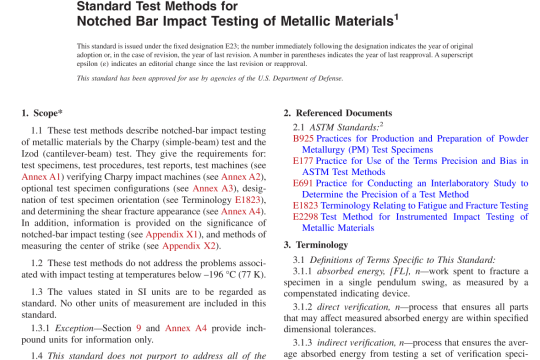ASTM F72-2017 pdf free download
ASTM F72-2017 pdf free download.Standard Specification for Gold Wire for Semiconductor Lead Bonding
1. Scope
1.1 This specification covers round drawn/extruded gold wire for internal semiconductor device electrical connections. Four classifications of wire are distinguished, (1) copper- modified wire, (2) beryllium-modified wire, (3) high-strength wire, and (4) special purpose wire. N OTE 1—Trace metallic elements have a significant effect upon the mechanical properties and thermal stability of high-purity gold wire. It is customary in manufacturing to add controlled amounts of selected impurities to gold to modify or stabilize bonding wire properties, or both. This practice is known variously as “modifying,” “stabilizing,” or “doping.” The first two wire classifications denoted in this specification refer to wire made with either of two particular modifiers, copper or beryllium, in general use. In the third and fourth wire classifications, “high-strength” and “special purpose” wire, the identity of modifying additives is not restricted. 1.2 The values stated in SI units shall be regarded as the standard. 1.2.1 A mixed system of metric and inch-pound units is in widespread use for specifying semiconductor lead-bonding wire. SI-equivalent values of other commonly used units are denoted by parentheses in text and tables. 1.3 The following hazard caveat pertains only to the test method portion, Section 9, of this specification. This standard does not purport to address all of the safety, health, and environmental concerns, ifany, associated with its use. It is the responsibility of the user of this standard to establish appro- priate safety and health practices and determine the applica- bility ofregulatory limitations prior to use. 1.4 This international standard was developed in accor- dance with internationally recognized principles on standard- ization established in the Decision on Principles for the Development of International Standards, Guides and Recom- mendations issued by the World Trade Organization Technical Barriers to Trade (TBT) Committee.
7. Workmanship, Finish, and Appearance
7.1 The wire surface shall be clean and free of finger oils and stains. 7.2 The wire surface shall be free of drawing/extrusion lubricant residues, particulate matter and other contaminants that would interfere with functional performance of the wire. The seller and the purchaser must agree upon acceptable standard of surface cleanliness. 7.3 The surface shall be free of surface contamination that would degrade service life ofthe device to which it is attached. The seller and the purchaser must agree upon acceptable standard of surface cleanliness. 7.4 The wire surface shall be free of nicks, dents, scratches, or other blemishes deeper than 5 % of the wire diameter. The surface shall be free of flaws protruding more than 5 % of the wire diameter above the surface. 7.5 The wire shall despool without excessive curl that would degrade functional performance. The seller and the purchaser must agree upon acceptable amount of curl. Curl is measured by the springback test (9.5). 7.6 The wire must be free of twist about the wire axis. Referring to wire twist test procedure (9.6), wire entwining upon itselfone or more complete turns (9.6.5.4) is rejectable by the purchaser. Lesser degrees of twist may be acceptable, as agreed upon between seller and purchaser. 7.7 The wire cross section must not be out-of-round to such an extent that functional performance is impaired. The seller and the purchaser must agree upon acceptable amount of out-of-roundness.N OTE 4—It is the intention of the directly responsible Subcommittee, F01.07, that the term “functional performance” be narrowly construed as follows: wire imperfections denoted in 7.2, 7.5, and 7.7 must not be of sufficient severity to excessively impair the operation of an otherwise normally functioning wire bonding machine. In practice, standards of adequate “functional performance” vary considerably, depending upon application.




